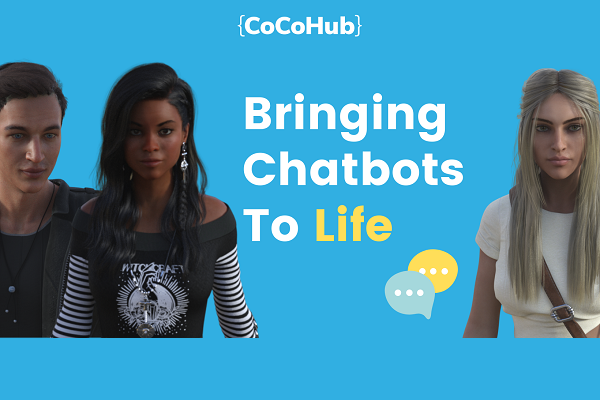How CoCoHub Shepherds Custom Virtual Humans to Your Zoom Conference
 Israeli conversational AI startup CoCoHub offers a platform for people to build their own Zoom conference attendees. By combining a vocal chatbot with computer-generated images on CocoHub’s platform, users can create artificial humans that can then be exported to Zoom for video calls of a slightly different nature from the ones many have grown used to over the last year.
Israeli conversational AI startup CoCoHub offers a platform for people to build their own Zoom conference attendees. By combining a vocal chatbot with computer-generated images on CocoHub’s platform, users can create artificial humans that can then be exported to Zoom for video calls of a slightly different nature from the ones many have grown used to over the last year.
Zoom Bot
CoCoHub is best described as a customizable chatbot creator. Pre-built pieces of software can be picked out to design a personality that can communicate in voice and chat, including a visual for video conversations. The whole process can be completed in about half an hour with no coding or training, although those wanting to dive into the technical elements can do so. Once complete, the chatbot can be published almost anywhere. A universal chatbot that can be at home in any system was the goal that inspired CoCoHub’s creation.
“The main problem we recognized was that there was no collaboration,” CoCoHub CTO and co-founder Chen Buskilla said in an interview with Voicebot. When you still have so many platforms, and they allow you to build the bots in so many different ways, but they are not talking with each other. Every time you start a new project, a new bot, you need to start from scratch. You cant take the previous bot you wrote and take only the relevant part and then extend it; you need to start from scratch every time. We saw it as a huge hurdle to getting chatbots to everywhere.”
Zoom is only the newest option for hosting a CoCoHub chatbot. Websites and Facebook Messenger can embed the chatbot in text or audio form. The AI can also be made into an Alexa skill or even connected to a phone number that people call or text. Still, Zoom is proving to be very popular, with more than 1,000 deployments in less than a month. The company envisions a lot of uses for its chatbots on Zoom, specifically. CoCoHub suggested that the AI handle job interviews and new employee onboarding, moderate events, or serve as a brand ambassador.
“We define a standard. it’s called conversational components, that let you assemble a few pre-built components into a chatbot, and you can reuse them between chatbots,” Buskilla said. “It’s not only for a singular use case.
Virtual Influence
Anna The Companionship Bot showcases some of CoCoHub’s ambitions. Anna is a digital influencer on behalf of CoCoHub and has been making a splash in media appearances discussing everything from Middle Easy peach proposals to her pop music single (generated by an algorithm) called A Change is Coming. Anna even conducted a wedding this month. CoCoHub is garnering plenty of interest across many industries, despite skepticism about how effective its chatbots can be. Advertising agencies, financial institutions, and e-commerce companies are all discussing ways to implement CoCoHub’s chatbots into their businesses.
“We’re just enabling everybody to create their own chatbots in minutes and then deploy it,” CoCoHub marketing head Eran Soroka said. “We’re bringing chatbots to life.”
There’s also a lot of potential in AI-enhanced education. CoCoHub recently began working with Pakistani entrepreneur and activist Saba Khalid to extend the reach of her chatbot Raaji or Aurat Raaj, “women rule” in Urdu. Raaji is a chatbot Khalid designed to teach Pakistani women about sexual health, gender equality, and other delicate topics. CoCoHub has since helped bring Raji to new audiences through online video chat services like Zoom.
“We were really excited about this cooperation, so we guided her on how to publish her chatbot on Zoom calls, and honestly – when we saw her first use of it, a week later, we had tears of joy filling our eyes,” Soroka said. “Since then, we’ve decided to help her expand the chatbot’s reach and to search for ways to enhance its capabilities and find additional resources. For us, Raaji’s case perfectly fits our mission and vision at CoCoHub: to use conversational AI for good, help marginalized populations and communities, and make chatbots accessible for everybody.”
Universal Chatbots
The COVID-19 pandemic has spurred a surge of interest in text and voice-based chatbots, in general. Healthcare providers reducing demand on staff time, businesses keeping customers updated, and government agencies relaying the latest guidelines all use chatbots, sometimes for the first time. But, that doesn’t mean there isn’t a lot of space where the technology could be used but just isn’t, despite everything that’s happened in the last year and how simple creating a chatbot is, according to Soroka.
“Even now, almost a year into the coronavirus [pandemic] that put the whole world on lockdown, there’s not enough openness for chatbots on the market. A lot of people still see chatbots as a utility for call centers or e-commerce and don’t realize it has thousands of possible use cases,” Soroka said. “So one of our missions is to make chatbots accessible to everyone, from current conversation designers to journalists, artists, marketers, therapists, educators, and everybody else. I [have] lectured to elementary school pupils, including nine-year-old kids who built and deployed a chatbot in less than 30 minutes. We want to prove that everybody can create a chatbot.”
Follow @voicebotai Follow @erichschwartz
Bored of Zoom Meetings? Build a Digital Clone to Attend for You
New Chatbot Project Turns Conversational AI into an Improv Performance








